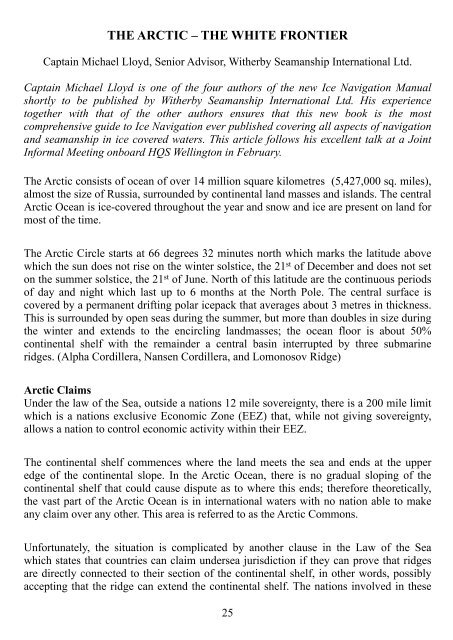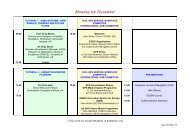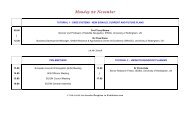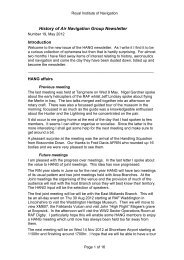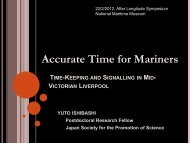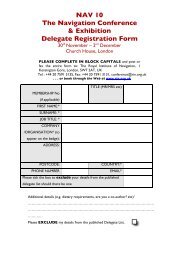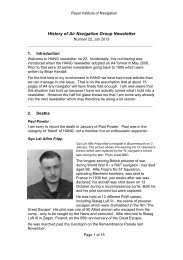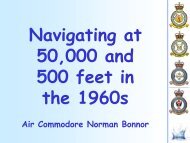Fairway 30 - Royal Institute of Navigation
Fairway 30 - Royal Institute of Navigation
Fairway 30 - Royal Institute of Navigation
Create successful ePaper yourself
Turn your PDF publications into a flip-book with our unique Google optimized e-Paper software.
THE ARCTIC – THE WHITE FRONTIER<br />
Captain Michael Lloyd, Senior Advisor, Witherby Seamanship International Ltd.<br />
Captain Michael Lloyd is one <strong>of</strong> the four authors <strong>of</strong> the new Ice <strong>Navigation</strong> Manual<br />
shortly to be published by Witherby Seamanship International Ltd. His experience<br />
together with that <strong>of</strong> the other authors ensures that this new book is the most<br />
comprehensive guide to Ice <strong>Navigation</strong> ever published covering all aspects <strong>of</strong> navigation<br />
and seamanship in ice covered waters. This article follows his excellent talk at a Joint<br />
Informal Meeting onboard HQS Wellington in February.<br />
The Arctic consists <strong>of</strong> ocean <strong>of</strong> over 14 million square kilometres (5,427,000 sq. miles),<br />
almost the size <strong>of</strong> Russia, surrounded by continental land masses and islands. The central<br />
Arctic Ocean is ice-covered throughout the year and snow and ice are present on land for<br />
most <strong>of</strong> the time.<br />
The Arctic Circle starts at 66 degrees 32 minutes north which marks the latitude above<br />
which the sun does not rise on the winter solstice, the 21 st <strong>of</strong> December and does not set<br />
on the summer solstice, the 21 st <strong>of</strong> June. North <strong>of</strong> this latitude are the continuous periods<br />
<strong>of</strong> day and night which last up to 6 months at the North Pole. The central surface is<br />
covered by a permanent drifting polar icepack that averages about 3 metres in thickness.<br />
This is surrounded by open seas during the summer, but more than doubles in size during<br />
the winter and extends to the encircling landmasses; the ocean floor is about 50%<br />
continental shelf with the remainder a central basin interrupted by three submarine<br />
ridges. (Alpha Cordillera, Nansen Cordillera, and Lomonosov Ridge)<br />
Arctic Claims<br />
Under the law <strong>of</strong> the Sea, outside a nations 12 mile sovereignty, there is a 200 mile limit<br />
which is a nations exclusive Economic Zone (EEZ) that, while not giving sovereignty,<br />
allows a nation to control economic activity within their EEZ.<br />
The continental shelf commences where the land meets the sea and ends at the upper<br />
edge <strong>of</strong> the continental slope. In the Arctic Ocean, there is no gradual sloping <strong>of</strong> the<br />
continental shelf that could cause dispute as to where this ends; therefore theoretically,<br />
the vast part <strong>of</strong> the Arctic Ocean is in international waters with no nation able to make<br />
any claim over any other. This area is referred to as the Arctic Commons.<br />
Unfortunately, the situation is complicated by another clause in the Law <strong>of</strong> the Sea<br />
which states that countries can claim undersea jurisdiction if they can prove that ridges<br />
are directly connected to their section <strong>of</strong> the continental shelf, in other words, possibly<br />
accepting that the ridge can extend the continental shelf. The nations involved in these<br />
25


